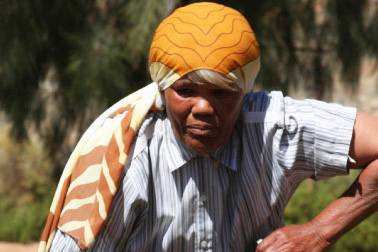
By Amanda Bourne
Every spring, wildflowers bloom by the thousands in Namaqualand’s coastal grasslands; for most of the rest of the year the region is a dry, dusty, semi-arid desert. It is also one of the key areas in South Africa predicted to be hardest hit by the impacts of climate change, including rising average temperatures and incre asingly unpredictable rainfall in an already hot and extremely water-scarce region.
Conservation South Africa’s (CSA) small grants programme, Skeppies, has been supporting the development of community-based green businesses in Namaqualand for several years; in 2009, we began working closely with the Skeppies projects to build their resilience to climate change.
Our first step was to raise awareness about how shifting weather patterns can affect the projects, which range from collecting kelp for sale as organic fertilizer to using Anatolian shepherd dogs to guard livestock and deter predators. We gave all the project implementers rain gauges, electronic thermometers and a ‘climate diary’ to record their daily weather observations. We worked with project implementers like Vera Engelbrecht, owner of Vera’s Kookskerm and Guest House in Leliefontein, to make the information they collected relevant for their planning.
Kookskerms are traditional Nama catering operations in Namaqualand that prepare traditional dishes over open fires and serve it in reed huts, providing a unique cultural experience and delicious food for tourists and locals alike. At a recent climate change workshop, Vera told us, “The diary was very useful to the project, as many tourists asked what the weather had been like the week before, and I could just look through the diary and give them the information.”
Detailed weather observations have had a great impact on project success. John Basson from the Bravo Pro Kelp Drying Project told us that they were able to plan their work schedule more effectively with the weather and save a lot of money. All the project implementers found collecting their own information about the weather and comparing it with three-month weather forecasts from the South African Weather Services and the daily radio or television weather reports to be a very interesting exercise.
The projects’ climate monitoring systems have received a lot of attention in the wider communities; Says Hanna Claasen from Kamieskroon, “The diary was useful, and the rest of the community thought it was interesting too.”
Some projects have expanded their climate monitoring to also include recording data on wind patterns and ocean temperature. We are now working with Skeppies projects to install sophisticated automated weather stations in some areas, to introduce good science and encourage the projects’ partners and community members to also engage with and learn from the climate monitoring process. Awareness of the impact of the weather has also enabled the projects to identify appropriate adaptation options and they’ve already successfully appealed to our ‘climate tech’ programme for adaptation infrastructure like water tanks and wind breaks.
Thanks to actions like these, people can be more aware of present climate change impacts and prepared for what will happen in the future.
Amanda Bourne is the climate adaptation coordinator for Conservation South Africa.

